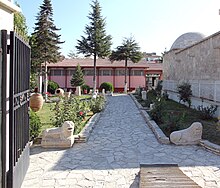Karaman Museum
The Karaman Museum ( Turkish Karaman Müzesi ) is an archaeological and ethnographic museum in the southern Turkish city of Karaman in the province of the same name . It is located in the city center on Turgut Özal Caddesi, behind the Hatuniye Medresesi theological college . It houses exhibits from the period from the Neolithic to the Byzantine era , in the ethnographic part from the Seljuk to Ottoman and modern times.
history
After the archaeological finds from the area around Karaman were initially taken to other museums in Turkey, the first museum was founded in 1961 on the premises of the tourism association. In 1963 the collection was moved to a building in the center, in 1966 in the Ibrahim Bey poor kitchen, in 1968 in a rented house and in 1971 in the current building, which was officially opened in 1980. It consists of two floors, of which only the upper one is in use today (2017). A second exhibition room, storage and technical rooms are planned for the lower floor.
exhibition
The upper floor has a floor area of 550 square meters, which includes administrative rooms and two halls with 32 showcases, one for archaeological and one for ethnographic exhibits. The oldest pieces of the archaeological collection come from the prehistoric settlement hill Canhasan ten kilometers northeast of Karaman. These include ceramics, stone axes, obsidian arrowheads, scrapers, and trinkets. Ceramic finds from the Sısanın Höyük and the Western Anatolian Yortan culture as well as Hittite stamps and cylinder seals belong to the Bronze Age . The finds of the Hellenistic era are clay vessels, mainly plates and lekythoi , among others from Kelenderis . The finds from the Roman and Byzantine eras include busts found in Philadelphia near Ermenek in 2015 , a sarcophagus, ceramics, glass bottles and wooden objects. Worth mentioning is a female corpse with remains of clothing from the Manazan caves near Taşkale, east of Karaman, which is dated to the 11th to 12th centuries. The collection also includes a rich coin collection with Greek, Venetian, Roman, Byzantine and Ottoman specimens, including from the Karamanoğulları period .
The second hall shows folkloric artefacts from the time of the Seljuks, the Anatolian principalities ( Beyliks ), the Ottomans and the Turkish Republic.
According to the museum management, the collection includes 4,231 archaeological and 2,095 ethnographic exhibits as well as 6,732 coins. The director of the museum is Abdülbari Yıldız.
Web links
- Official website (English).
- www.gokaraman.gov.tr (with virtual tour)
Individual evidence
- ↑ http://www.kultur.gov.tr/EN,113966/karaman-museum.html
- ↑ Karaman Tarihi Platformu ( page no longer available , search in web archives ) Info: The link was automatically marked as defective. Please check the link according to the instructions and then remove this notice. (Turkish)
- ↑ Karaman Müze Müdürlüğü
- ↑ Karaman Tarihi Platformu ( page no longer available , search in web archives ) Info: The link was automatically marked as defective. Please check the link according to the instructions and then remove this notice. (Turkish)
Coordinates: 37 ° 10 ′ 57.3 ″ N , 33 ° 12 ′ 42 ″ E




